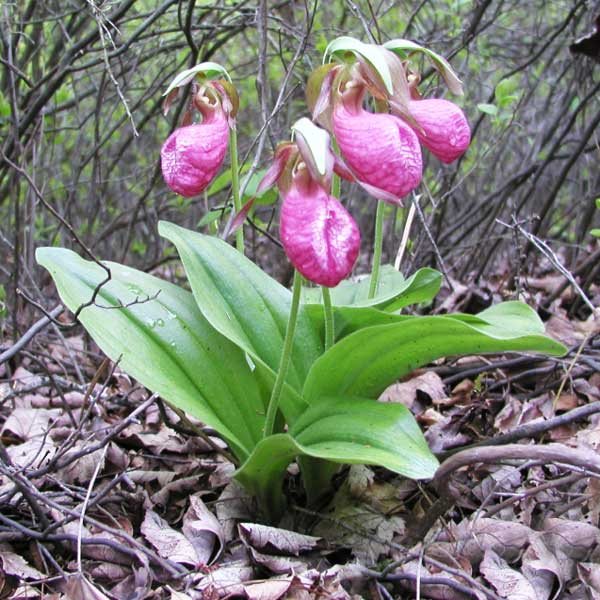
Upland Orchids
Hardy Terrestrial Orchids - Cypripedium, Bletilla, Tipularia
Hardy Orchids are terrestrial orchids that tolerate cold winters. They often grow in or near bogs, especially in the transition zones between bog and forest. Bog species like the Grass Pinks, (Calogogon), and Lady Tresses (Spiranthes) grow in the wet areas of bogs, pocosin or fens, and the upland orchids grow up in the well drained slopes above the wet areas. They prefer open and partially shaded, drier areas with woodsy soil that is moist, but well drained, and loose leaf cover. They frequently grow in large colonies along with trillium, may apples and blue bells.They are wonderful companions along the outside margins of carnivorous plant gardens.
Hardy orchids were once believed to be very difficult plants to transplant and grow in the garden. This is not the case anymore. We've learned a lot about them recently and have come to understand that the key to successful growing is providing the right conditions. pH is probably the most important factor, along with winter conditions. It was once believed that Hardy Orchids require a symbotic relationship with soil fungus (mycorrhizal associations) in order to grow and last beyond a year or two. This is true for growing seedlings, but we've learned that this is not necessary for adult plants. Orchid seeds are unique in the Plant Kingdom. They only contain an embryo and no cotyledon with stored energy for seedling growth. In order for them to grow, seedlings need the help of soil fungus to assist with their nutrient supply. As they mature, they outgrow this need for infant support, and can grow independently without the soil fungus.
Upland Orchids need acidic conditions, and benefit from the slow release of nutrients from decomposing humus. A good soil mix is 1:1:1:1 peat:sand:pine bark fines:leaf mould. Peat provides the acidic, and moisture holding capacity. Sand provides good drainage with no nutrients. Pine bark fines and leaf mould provide a slow and low release of nutrients. Note: Pine bark fines are usually from loblolly pine, ground into pieces 1/4" or less with a lot of smaller particle sizes. It is partially decomposed for 1 or 2 years. Leaf mould is shredded, partially decomposed oak or beech leaves. I prefer not to use perlite because it eventually floats to the surface and can look ugly and become a nuisance. I do not use vermiculite because it eventually decomposes into a slimey clay and compacts the soil. Most Lady Slippers prefer slight lower pH and benefit from 1 tablespoon of pelletized lime added to each 6-8" pot portion. These species include: Cypripedium praviflorum, C. pubsscens, C. reginae, but not the Pink Lady Slipper, C. acaule.
Orchid roots need room to grow. They are wide spreading and grow near the soil surface. In a pot the roots tend to wind around the outside, making water absorption more challenging. So use a wide pot or plant them in the bog garden.
Orchids are spectacular flowering plants. Indeed, they are usually grown for their flowers. They are rather unusual in that by most flower standards, the blooms are upside down, and often have elaborate mechanisms of pollination. Some require only specific pollinator species to work their way through elaborate petal arrangements, and emerge on the other side coated with pollen. In cultivation, seeds are typically infrequent, difficult to start and take several years (sometimes decades) to sprout and mature. On the other hand, some, like Spiranthes and Calopogon are easy and will become volunteers in the bog garden by their own means.
The growing range for most Hardy Orchids is considerably wide. They naturally grow in Zones 3 to 9 in the eastern half of North America from Alberta and Newfoundland to Georgia and Alabama. This wide, natural range means they are very tolerate of winter conditions. I have found that most do well with winter temperatures of 45°F (7°C) when grown indoors, and outdoors in the ground can take temperatures below -22°F (-30°C). They do benefit from pine needle or weed free hay mulching, about 4-6" deep. This helps retain soil moisture and keeps winter temperatures from extreme fluctuation.
We provide nursery-propagated species which often take 7 or more years from tissue culture to mature thriving plant.



